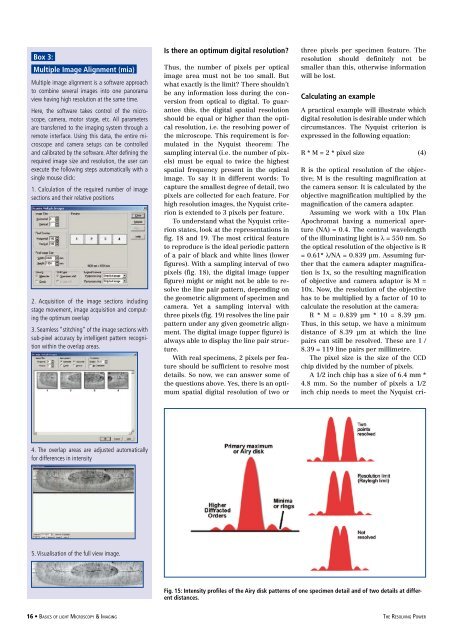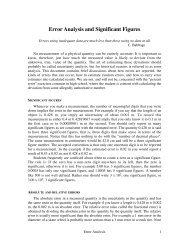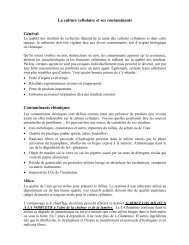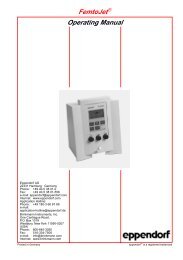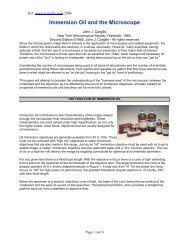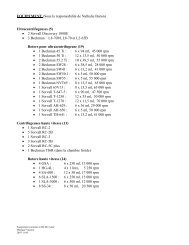Basics of Light Microscopy Imaging - AOMF
Basics of Light Microscopy Imaging - AOMF
Basics of Light Microscopy Imaging - AOMF
Create successful ePaper yourself
Turn your PDF publications into a flip-book with our unique Google optimized e-Paper software.
Box 3:<br />
Multiple Image Alignment (mia)<br />
Multiple image alignment is a s<strong>of</strong>tware approach<br />
to combine several images into one panorama<br />
view having high resolution at the same time.<br />
Here, the s<strong>of</strong>tware takes control <strong>of</strong> the microscope,<br />
camera, motor stage, etc. All parameters<br />
are transferred to the imaging system through a<br />
remote interface. Using this data, the entire microscope<br />
and camera setups can be controlled<br />
and calibrated by the s<strong>of</strong>tware. After defining the<br />
required image size and resolution, the user can<br />
execute the following steps automatically with a<br />
single mouse click:<br />
1. Calculation <strong>of</strong> the required number <strong>of</strong> image<br />
sections and their relative positions<br />
2. Acquisition <strong>of</strong> the image sections including<br />
stage movement, image acquisition and computing<br />
the optimum overlap<br />
3. Seamless “stitching” <strong>of</strong> the image sections with<br />
sub-pixel accuracy by intelligent pattern recognition<br />
within the overlap areas.<br />
Is there an optimum digital resolution<br />
Thus, the number <strong>of</strong> pixels per optical<br />
image area must not be too small. But<br />
what exactly is the limit There shouldn’t<br />
be any information loss during the conversion<br />
from optical to digital. To guarantee<br />
this, the digital spatial resolution<br />
should be equal or higher than the optical<br />
resolution, i.e. the resolving power <strong>of</strong><br />
the microscope. This requirement is formulated<br />
in the Nyquist theorem: The<br />
sampling interval (i.e. the number <strong>of</strong> pixels)<br />
must be equal to twice the highest<br />
spatial frequency present in the optical<br />
image. To say it in different words: To<br />
capture the smallest degree <strong>of</strong> detail, two<br />
pixels are collected for each feature. For<br />
high resolution images, the Nyquist criterion<br />
is extended to 3 pixels per feature.<br />
To understand what the Nyquist criterion<br />
states, look at the representations in<br />
fig. 18 and 19. The most critical feature<br />
to reproduce is the ideal periodic pattern<br />
<strong>of</strong> a pair <strong>of</strong> black and white lines (lower<br />
figures). With a sampling interval <strong>of</strong> two<br />
pixels (fig. 18), the digital image (upper<br />
figure) might or might not be able to resolve<br />
the line pair pattern, depending on<br />
the geometric alignment <strong>of</strong> specimen and<br />
camera. Yet a sampling interval with<br />
three pixels (fig. 19) resolves the line pair<br />
pattern under any given geometric alignment.<br />
The digital image (upper figure) is<br />
always able to display the line pair structure.<br />
With real specimens, 2 pixels per feature<br />
should be sufficient to resolve most<br />
details. So now, we can answer some <strong>of</strong><br />
the questions above. Yes, there is an optimum<br />
spatial digital resolution <strong>of</strong> two or<br />
three pixels per specimen feature. The<br />
resolution should definitely not be<br />
smaller than this, otherwise information<br />
will be lost.<br />
Calculating an example<br />
A practical example will illustrate which<br />
digital resolution is desirable under which<br />
circumstances. The Nyquist criterion is<br />
expressed in the following equation:<br />
R * M = 2 * pixel size (4)<br />
R is the optical resolution <strong>of</strong> the objective;<br />
M is the resulting magnification at<br />
the camera sensor. It is calculated by the<br />
objective magnification multiplied by the<br />
magnification <strong>of</strong> the camera adapter.<br />
Assuming we work with a 10x Plan<br />
Apochromat having a numerical aperture<br />
(NA) = 0.4. The central wavelength<br />
<strong>of</strong> the illuminating light is l = 550 nm. So<br />
the optical resolution <strong>of</strong> the objective is R<br />
= 0.61* l/NA = 0.839 µm. Assuming further<br />
that the camera adapter magnification<br />
is 1x, so the resulting magnification<br />
<strong>of</strong> objective and camera adaptor is M =<br />
10x. Now, the resolution <strong>of</strong> the objective<br />
has to be multiplied by a factor <strong>of</strong> 10 to<br />
calculate the resolution at the camera:<br />
R * M = 0.839 µm * 10 = 8.39 µm.<br />
Thus, in this setup, we have a minimum<br />
distance <strong>of</strong> 8.39 µm at which the line<br />
pairs can still be resolved. These are 1 /<br />
8.39 = 119 line pairs per millimetre.<br />
The pixel size is the size <strong>of</strong> the CCD<br />
chip divided by the number <strong>of</strong> pixels.<br />
A 1/2 inch chip has a size <strong>of</strong> 6.4 mm *<br />
4.8 mm. So the number <strong>of</strong> pixels a 1/2<br />
inch chip needs to meet the Nyquist cri-<br />
4. The overlap areas are adjusted automatically<br />
for differences in intensity<br />
5. Visualisation <strong>of</strong> the full view image.<br />
Fig. 15: Intensity pr<strong>of</strong>iles <strong>of</strong> the Airy disk patterns <strong>of</strong> one specimen detail and <strong>of</strong> two details at different<br />
distances.<br />
16 • <strong>Basics</strong> <strong>of</strong> light <strong>Microscopy</strong> & <strong>Imaging</strong> the Resolving Power


